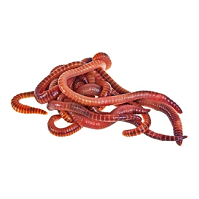Composting-optimized red worms: Why they matter for gardens
Composting-optimized red worms: Why they matter for gardens
Blog Article
Making Use Of Red Wigglers for Effective Organic Garbage Disposal
Using red wigglers for organic garbage disposal presents an engaging method to taking care of food scraps while promoting ecological sustainability. These worms not only boost waste decay but likewise yield useful worm castings, which can substantially improve dirt health. Their capability to refine big quantities of organic material with marginal effort placements them as an available remedy for households and areas alike. Understanding the nuances of establishing up an effective worm bin and maintaining an ideal environment is crucial for maximizing their advantages. The following actions in this process may shock you.
Benefits of Using Red Wigglers
Among the most compelling advantages of utilizing red wigglers for natural waste disposal is their exceptional efficiency in composting. These worms, scientifically recognized as Eisenia fetida, are particularly adapted for breaking down natural materials, allowing them to process waste as much as twice their body weight each day. This rapid disintegration not only accelerates the composting process yet additionally produces nutrient-rich worm spreadings that considerably enhance soil high quality.
Furthermore, red wigglers add to a decrease in landfill waste. By drawing away natural products from landfills, they help lessen methane exhausts-- a potent greenhouse gas. This environmental advantage is important in the battle against climate change.
In addition, red wigglers are low-maintenance and can grow in numerous atmospheres, making them easily accessible for both beginner and experienced composters. Their capacity to duplicate swiftly guarantees a steady populace, assisting in ongoing waste handling.
Establishing Your Worm Bin
Developing a reliable worm container is necessary for making the most of the advantages of composting with red wigglers. Make sure the container has sufficient water drainage holes to stop excess moisture, as red wigglers flourish in a wet however not soaked environment.
(red wiggler worms for sale)Following, prepare the bed linens product, which offers as the worms' habitat and food source. Shredded newspaper, cardboard, and coconut coir are excellent alternatives. Go for a bed linens deepness of about 4 to 6 inches. The bin should be positioned in a dark, temperature-controlled location, ideally between 55 ° F and 77 ° F, to keep worm task.
Once the container is set up, present the red wigglers, allowing them to adapt to their new setting. A well-maintained container will not only sustain the health of the worms yet also assist in efficient decomposition of natural waste.
(red wiggler worms)
What to Feed Red Wigglers
An understanding of the suitable diet plan for red wigglers is important for preserving a healthy worm population and optimizing composting performance. Red wigglers grow on a varied diet regimen that mostly contains organic materials. Ideal food resources consist of vegetable scraps, fruit peels, coffee grounds, eggshells, and shredded paper. These items not just supply necessary nutrients however also contribute to the dampness equilibrium within the worm bin.
It is crucial to stay clear of specific foods that can harm the worm populace. Red wigglers must not be fed meat, dairy items, oily foods, or processed things, as these can draw in insects and develop unpleasant smells. red wigglers. Furthermore, citrus fruits and spicy foods need to be lessened, as their acidity can be damaging to worms
Monitoring the worm bin for food intake prices will assist make certain that red wigglers are receiving a sufficient diet plan while keeping an efficient composting atmosphere. Appropriate feeding techniques are essential for fostering a prospering ecological community within the worm bin.
Maintaining Your Worm Habitat
A properly maintained worm environment is necessary for the wellness and efficiency of red wigglers. To guarantee ideal conditions, it is essential to monitor temperature, dampness, and oygenation within the worm container (red wigglers).
Wetness levels must be maintained consistent; the bed linens must be moist but not soaked. A great general rule is to maintain dampness at approximately 70% to 80%. If the bed linen becomes also wet, it can cause anaerobic problems that are hazardous to the worms. Adding completely dry carbon-rich products, such as shredded paper or cardboard, can assist take in excess wetness.

Utilizing Worm Spreadings in Horticulture
Rich in nutrients and helpful microbes, worm spreadings act as a remarkable organic fertilizer for horticulture. Generated through the digestive processes of red wigglers, these castings contain a range of vital nutrients, including nitrogen, phosphorus, and potassium, which promote robust plant growth. Unlike artificial plant foods, worm spreadings supply a slow-release device, making sure that nutrients are offered to plants over a prolonged period, thus decreasing the risk of nutrient leaching and soil deficiency.
In enhancement to nutrition content, worm spreadings enhance dirt structure and aeration, enhancing moisture retention and water drainage. The microbial life present in worm castings assists to suppress virus and promotes a healthy and balanced dirt community, further profiting plant health. When integrated into the soil or made use of as a top clothing, worm castings can dramatically increase seed germination prices, root advancement, and overall plant vigor.
For optimum results, garden enthusiasts should use worm spreadings at a rate of 1-2 inches per square foot, blending them right into the soil or including them right into potting mixes. On the whole, using worm castings is an eco-friendly method to improving soil fertility and making sure growing garden atmospheres.
Verdict

Report this page